Color is starting to spring up around us as the seasons change, and our creative prompt capitalizes on the color in the world, so I thought I would talk a bit about some notable historic pigments. This is in no way comprehensive, as there are numerous cultures and civilizations using many different pigments going back thousands of years, but I have pick a few colors to highlight.
Maya Blue
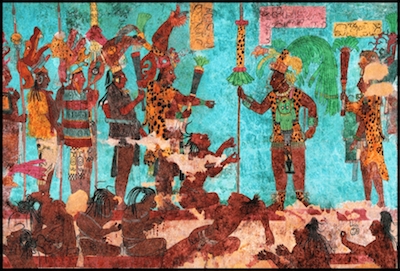
Mural from the second room at Bonampak, a Maya archeological site in Chiapas, Mexico. The background shows the bright Maya Blue color, amid a scene of military defeat.
Maya Blue is the name given to a brilliant blue pigment found in Pre-Columbian Mesoamerican art, particularly Maya art. Mainly composed of the mineral attapulgite, also known as palygorskite, a mineral found in clay soils, mixed with the plant dye indigo, giving the pigment it’s remarkable blue color. This color can be found in murals, including the Maya mural above from Bonampak, ceramics, sculptures, codices, and possibly even on human sacrifices.
Vermillion/Cinnabar
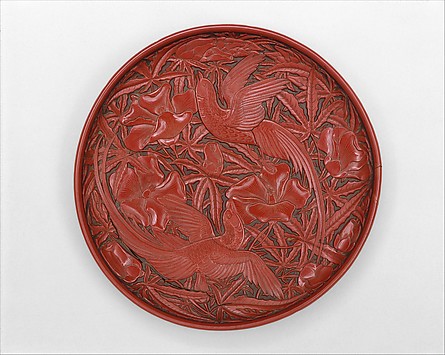 Carved red lacquer colored with cinnabar from the Met, 14th C. China
Carved red lacquer colored with cinnabar from the Met, 14th C. China
Vermillion is a bright red pigment, usually made from crushed cinnabar, a form of mercury sulfide. Like many compounds with mercury, it is quite toxic. Vermillion seems to be the favored term in England and the United States for the color, while cinnabar is more commonly used when referring to the mineral. This pigment is used across many cultures, including the neolithic site Catalhoyuk in modern day Turkey, in art in Ancient Rome, in pre-Columbian Central and South America, and in Chinese lacquerware, starting during in the 3rd century BCE during the Han Dynasty. It has even been found including numerous human burials, most notably in the Tomb of the Red Queen, a Maya burial at Palenque, just to mention a few.
Tyrian Purple
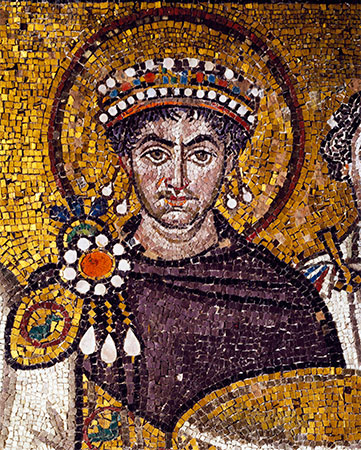 Emperor Justinian from a Mosaic at San Vitale, Ravenna, Italy, Byzantine, wearing a Tyrian Purple, finished around 547 CE
Emperor Justinian from a Mosaic at San Vitale, Ravenna, Italy, Byzantine, wearing a Tyrian Purple, finished around 547 CE
Tyrian purple, also called Phoenician Purple and royal purple among others, is a purpleto red dye. It was the most expensive ancient color, made from the secretions of the mollusk Murex, a group of Mediterarrean sea snails. Producing the dye took over 10,000 snails to produce 1.4 grams. Thought to originate with the Phoenicians, there is some evidence it came even earlier, and was used for those in power through the Roman empire. While the use of the dye waned after the fall of the Roman empire, the association of purple with royalty remained.
Cochineal/Carmine
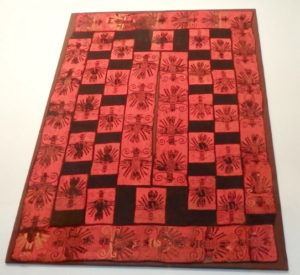
Detail of cloak dyed with cochineal, from the National Museum of Archeology, Lima, Paracas 250 BCE – 200 CE
Like vermillion, carmine is another bright red pigment. Sometimes referred to as cochineal, carmine is naturally derived from cochineal insects, which make carminic acid ironically as a defense mechanism. Carmine is used to broadly define a deep red, not just the pigment from cochineal, it originates with this pigment. Perhaps one of the best known uses of cochineal is in Pre-Columbian Peruvian texiles, from the Chuquibamba, Chimú, Chancay, and Inca.
Ochre
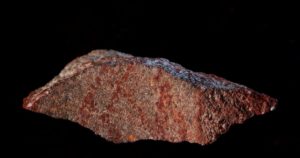 The oldest known drawing, in red ochre, found in Blombos Cave, South Africa, dating to 73,000 years ago
The oldest known drawing, in red ochre, found in Blombos Cave, South Africa, dating to 73,000 years ago
The final, and oldest, pigment is ochre. Ochre is perhaps the pigment metalsmiths are most familiar with, as yellow ochre can be used as a way of dirtying an solder seam to stop the solder from reflowing. However, ochre has been used as a pigment for thousands of years. Composed of ferric oxide and various types of clays and sands, it is a naturally occurring pigment found in clay-rich earth. While it forms a variety of colors, it is most commonly earthy reds, browns and yellows, and the yellowy-brown color “ochre” gets its name from this pigment. Ochre plays a significant role in cave images, appearing in early Indigenous Australian rock art, and at the famed Lascaux caves, and the Blombos Cave in South Africa estimated from 73,000 years ago, the first example we have of human drawing.
Latest posts by Metalwerx (see all)
- You helped make this year amazing! - November 29, 2021
- Announcing our Commitment to Continue In-Person AND Virtual Classes! - September 22, 2021
- Big Plans for Shopping Small for the Holidays - November 24, 2020
